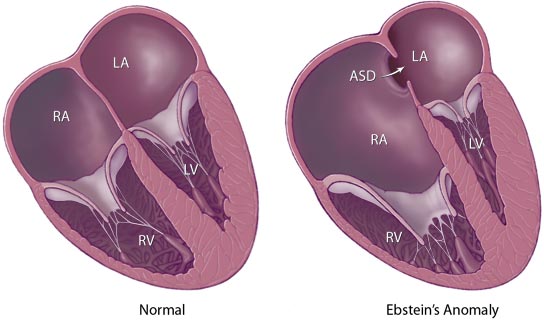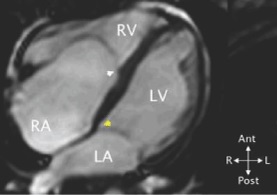WBR0514
| Author | [[PageAuthor::Gonzalo A. Romero, M.D. [1]]] |
|---|---|
| Exam Type | ExamType::USMLE Step 1 |
| Main Category | MainCategory::Anatomy, MainCategory::Behavioral Science/Psychiatry, MainCategory::Embryology, MainCategory::Pathology, MainCategory::Pharmacology |
| Sub Category | SubCategory::Cardiology, SubCategory::General Principles |
| Prompt | [[Prompt::A 5-year-old boy is brought to the emergency department by his mother for difficulty breathing and cyanosis. Physical examination reveals cyanotic extremities and bounding jugular venous pulsations. Initial imaging reveals the cardiac anomaly shown below. The physician suspects a medication related congenital abnormality. What is the most likely presentation of the mother considering the drug she was presumably prescribed? |
| Answer A | AnswerA::Mild episodes of increased shopping, rapid speech and insomnia lasting at least 2 years |
| Answer A Explanation | [[AnswerAExp::Cyclothymia is a milder form of bipolar lasting at least for 2 years, which commonly is treated with psychotherapy]] |
| Answer B | AnswerB::Hypersomnia, overeating, and mood reactivity |
| Answer B Explanation | [[AnswerBExp::This describes atypical depression, which is typically treated with MAO inhibitors]] |
| Answer C | AnswerC::Alternating intense sad symptoms with episodes of increased shopping, rapid speech and insomnia intense in nature |
| Answer C Explanation | AnswerCExp::See overall explanation. |
| Answer D | AnswerD::Recurring intrusive thoughts, feelings, or sensations that cause severe distress; relieved partly by repetitive actions |
| Answer D Explanation | [[AnswerDExp::This refers to OCD (Obsessive compulsive personality disorder) which is commonly treated with SSRIs]] |
| Answer E | AnswerE::Excessive and unreasonable fear that interferes with normal function |
| Answer E Explanation | [[AnswerEExp::This refers to specific phobia, which is treated with SSRIs]] |
| Right Answer | RightAnswer::C |
| Explanation | [[Explanation::The picture is showing an atrialized portion of the right ventricle. The opening of the tricuspid valve is displaced towards the apex of the right ventricle of the heart (congenital apical displacement of the tricuspid valve that typically causes significant tricuspid regurgitation). This cardiologic malformation is known as Ebstein anomaly, which is highly associated with Lithium use during pregnancy. Lithium is used to treat bipolar disorder, which is characterized by intense depressive symptoms alternated with manic episodes (characterized by: distractibility, irresponsibility, seeks pleasure without regard to consequences (hedonistic), grandiosity-inflated self-esteem, flight of ideas-racing thoughts, in goal-directed activity/psychomotor agitation, insomnia, talkativeness or pressured speech.
 Educational Objective: Bipolar disorder is treated with lithium, a mood stabilizer, which is associated with Ebstein anomaly, an atrialization of the right ventricle. |
| Approved | Approved::Yes |
| Keyword | WBRKeyword::Ebstein anomaly, WBRKeyword::Lithium, WBRKeyword::Bipolar disorder |
| Linked Question | Linked:: |
| Order in Linked Questions | LinkedOrder:: |
